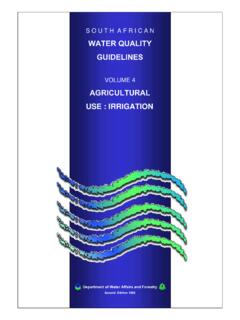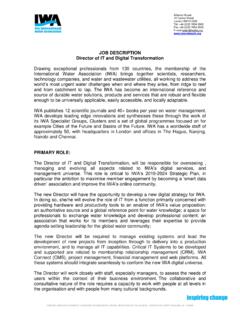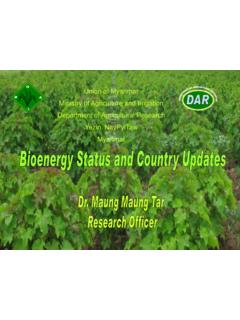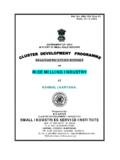Transcription of Request for Proposal – Video Documentary
1 Request for Proposal Video Documentary The International Water Association (IWA) under its project Hilsa-dependent Communities across India-Bangladesh Riverscapes is seeking Proposal (technical and financial) from individuals/organizations working in Bangladesh and India to produce a Video Documentary on the value of Hilsa conservation through cross-border cooperation. The Documentary should highlight the necessity of improving the life and livelihood of millions of fishermen and women with a focus on marginal communities, as identified by the project. The Proposal should be submitted preferably on or before February 15, 2017 via email. Email: Read below the Terms and Reference. Applications will be short listed and called for presentation for further evaluation. TERMS OF REFERENCE For Production of Documentary Film for: Sustainable Livelihoods for Hilsa-dependent Communities across India Bangladesh Riverscapes Hilsa fisheries sector plays an important role on the socioeconomic development of Bangladesh and West Bengal in India.
2 The fish is considered as a cultural symbol of the Bengalis. Although the fish production is on the wane in many countries, the production has been increasing at the rate of 8% to 10% every year in Bangladesh, according 1. to a World Fish Report. Bangladesh is the leading country in Hilsa production with 65% of all Hilsa, while India contributes to 10-15% and Myanmar 8-10%. The remaining Hilsa comes from other countries like, namely Bahrain and Kuwait's Arabian sea, the West Mid Pacific adjacent to Malaysia and Indonesia, Vietnam and Cambodia's Mekong, as well as China and Thailand's China Sea waters. According to the ministry of fisheries and livestock of Bangladesh, Hilsa contributes one percent of the country's total gross domestic product (GDP) and 11 percent of the country's total fish production. A total of half a million fishermen are directly involved with Hilsa catch.
3 The livelihood of another 2 million people is involved with this fish. In 2012 13, the value of Hilsa catch stood at over USD 2 billion. However, the sad part of this big industry is, most of the Hilsa fishers live below the poverty line, and most work in teams as labourers/fishers. The fishermen contribute to the larger economy, but they themselves fight with extreme poverty. The Government of Bangladesh and the Government of West Bengal, India have been working towards the improvement of the poverty ridden community but there has not been remarkable success. The Sustainable Livelihoods for Hilsa-dependent Communities across India-Bangladesh Riverscapes project is working towards facilitating stepwise consensus building and dialogues that will create multi-layered 1. understandings and interlinkages between sustainable livelihoods, Hilsa conservation and water management issues.
4 Background Trans-boundary water governance is a complex journey and focus needs to encompass not only water, but also themes such as energy, food security, fisheries and climate change. Quite often, issues of common interest, rather than the allocation of water itself, provides a more effective entry point for initiating mutually beneficial 2. cooperative actions . Moreover, integration of the bio-ecological and socio-political aspects of river courses are central to the assessment of the health of rivers. Water governance is most effective where stakeholders 3. participate and it is coordinated from local to national and transboundary levels . Most importantly, in both 4. countries so far Hilsa management has been based on regulatory policies focussed only on addressing overfishing . Therefore this project proposes to broaden the narrative to a more holistic approach to Hilsa conservation and livelihoods by integrating water management issues in the dialogue.
5 Hilsa fisheries play an important role in the region in terms of protein supply, generation of employment and earning of foreign currency. About 5 million fisher communities living in the lower riparian areas of the Ganges- Brahmaputra-Meghna region in Bangladesh and India depend directly on the fishery or indirectly through post- harvest activities. However, Hilsa has been on the decline over the last 30 years, due to over-fishing, siltation in 5. river beds, decrease in water flow from upstream and fragmentation of rivers in dry season . The Government of Bangladesh has taken measures, including implementing a ban on Hilsa fishing and recently the conservation efforts are moving from regulatory regimes to an approach that combines regulations with 6. economic incentives . Estimates from the Department of Fisheries, Bangladesh show that conservation efforts have resulted in an increase in catch over the last 10 years.
6 In India, in 2012, the State moved towards notifying all Hilsa producing states to take adequate steps for conservation. One of the key Hilsa producing and consuming states, West Bengal, has subsequently amended their respective inland and marine fisheries laws to implement a ban on Hilsa fishing during the spawning and breeding season. But the central challenge still remains on how to achieve a balance between conservation and fisheries-dependent livelihoods. Scope of Work: Overall aim of the assignment The objective of this Request For Proposal (RFP) is for a Documentary film that captures and promotes the value of Hilsa conservation through cross-border cooperation; and, the aim of the Documentary is to raise public awareness on conservation of Hilsa and portray the necessity of improving the life and livelihood of millions of fisher men and women with a focus on marginal communities, as identified by the project.
7 2. Pangare, G. and B. Nishat, 2014. Perspectives on Hydrodiplomacy. In Pangare Ganesh, editor Hydro-Diplomacy : Sharing Water Across Borders, New Delhi, India: Academic Foundation, 3. ibid 4 Dandekar, P. (2014) Collapsing Hilsa: Economic, ecological and cultural impact of dams. South Asia Network on Dams, Rivers and People. 5. Dewan A A, Naser M N, Bhaumik U, Hazra S and S B Bhattacharya (2014) Migration, spawning patterns and Conservation of Hilsa Shad (Tenualosa ilisa) in Bangladesh and India 6. Mohammed, E. Y. and Wahab. A. (2013). Direct economic incentives for sustainable fisheries management :the ncase of Hilsa conservation in Bangladesh. International Institute for Environment and Development, London. Deliverables and specific aims One Documentary Film' (approx. 10 - 12 minutes), suitable for broadcast on TV channels. Three small version of the film (approx.)
8 3 minutes each), suitable for (1) conference presentations on large screens and (2) internet and mobile internet use through platforms such as Vimeo, YouTube, Facebook etc. Specific Activities The main tasks of the Contractor/consultant/company/agency are as follows: Establish the team of technical personnel required for the production of the Video film Meeting with the IWA Team to conceptualize and concretize the expectations of the project and develop the scenario, theme and the work schedule of film production Submission of a preliminary story board and shot list for approval Onsite Filming Developing of a script with guidance from IWA Team. Films' narration will be in English. Subtitles/captions shall be prepared in English. Provision should be left to add national languages of countries in which footage is shot. Realizing the post-production process of the film (editing, dubbing, special effects and graphic animations, subtitles, music, etc.
9 , Submission for approval of one edited draft (with subtitles in English). Submission of at least 20 high quality photos from each project site they shoot. Submission of all original Documentary footage. Submission of 5 DVD copies of the film. Pitching the Documentary to at least 1 international TV channel that have a track record of broadcasting such documentaries will be considered as advantage. Timing and Duration: The Contractor/consultant/company/agency shall commence the work upon signing of contract and the contract shall expire as of July2017. Total pre-production, production and post-production time (including interim reviews, narrative and final production) should be finalized by the end of June 30, 2017. The rough cut of every phase of the Documentary should be provided to IWA for review and comments. Once final cut is given a green light, contractor/consultant/company/agency shall complete the work and submit for IWA's approval (legal consideration for broadcasting rights).
10 Ownership and broadcasting rights lie with IWA. The quality of the Documentary must be up to broadcast standards with a minimum quality of high definition. The contractor/consultant/company/agency shall provide full production and a ready-to-air product, : film, produce, edit, and provide music, voiceover and script and subtitle writing and translation. The contractor/consultant/company/agency shall submit a final version of the Documentary film in one of broadcast standards, preferably in High Definition DVD. Logistics: Contractor/consultant/company/agency will make its own logistical arrangements with support from IWA. Additional payment for travel, accommodation costs of the contractor and/or its crew will be fixed in consultation with IWA. The contractor/consultant and the designated production crews are expected to visit project sites in India and Bangladesh and spend approximately a total of 14 (fourteen) days maximum in the project locations.










